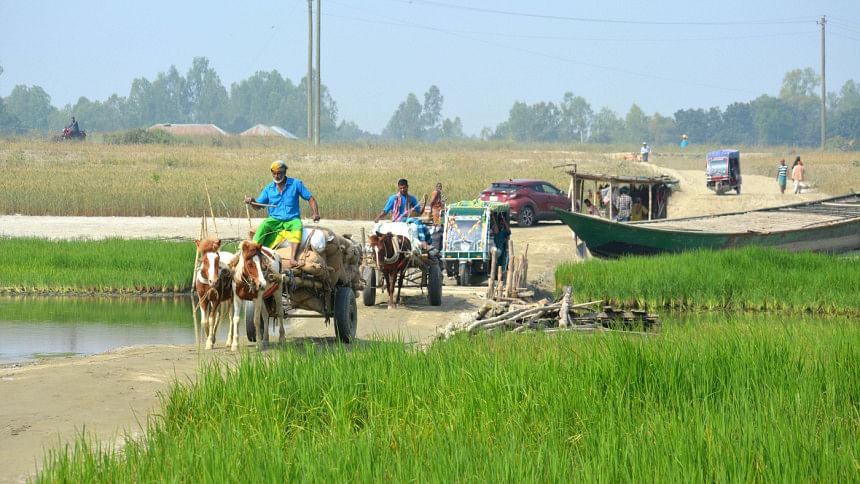Where did the rivers go?

Most of the rivers in Tangail remain waterless for six months during the dry season as silting and pollution are leading them to gradual death.
Water experts said the amount of water flow in Jamuna River has reduced a lot due to withdrawal of water from the upstream. The situation affects other connected rivers in the district including the Dhaleswari that has also silted up and as a result, their water containing capacity has greatly reduced, they said.
On the other hand, several rivers in the district have become highly polluted over the years. This pollution is causing serious damage to the life and livelihood of the local people.
The Bonshai and Louhajang rivers in Mirzapur and Sadar upazilas respectively are badly polluted due to discharge of untreated waste into the water bodies by local factories, especially those having printing and dying units.
Meanwhile, the main rivers in Tangail district are Jamuna, Dhaleswari, Jhenai, Bonshai, Louhajang and Elengjani.
The rivers were full of a variety of fishes while ships, launches, big merchant boats plied the rivers that had huge flow throughout the year only few decades ago, several senior citizens said.
River ways were used as means of easy and cheap transportation of goods from and to the district.
Big merchandising boats laden with thousands of maunds of jute from different districts came to the ghats of different rivers in the district including Elasin ghat on the Dhaleswari River in Delduar upazila and Nolin ghat in Gopalpur upazila as many governmental and non-governmental jute purchase centres were set up there.
But all these are past stories and now only some small engine boats can ply only on the Jamuna river during the dry season. As only a little water is available during about half of the year, the river transportation system in the district is in a disorder, they said.
Vehicles including sand-laden ones are seen plying the dried-up riverbeds.
Riverside fishermen and boatmen communities, who are mainly dependent on the rivers for their livelihood, are the direct victims of drying up of the rivers.
The rivers now see very little fish resources as their sanctuaries have been destroyed.
Prof ASM Saifullah of Department of Environmental Science and Resource Management of Mawlana Bhashani Science and Technology University said due to the construction of dams in the upstream of some major rivers of Bangladesh, the flow of water is decreasing during the dry season.
Millions of tonnes of silt coming with the water are accumulating at the bottom of the river due to low flow, and the depth is decreasing, creating shoals, he said.
On the other hand, it affects the branch rivers, there is almost no water in the rivers during the dry season. The dried-up river is being encroached upon by various structures, factories and household wastes are being dumped and thus the rivers are disappearing, he said.
To restore these rivers, dredging should continue, encroachment and pollution must stop, and better connections to main rivers should be established, he added.
Contacted, Matiur Rahman, executive engineer of Water Development Board (WDB) in Tangail, told The Daily Star that the rivers need dredging for getting back its navigability.
The WDB has already taking preparations to hold dredging on the Dhaleswari river and the works may start soon, he said.

 For all latest news, follow The Daily Star's Google News channel.
For all latest news, follow The Daily Star's Google News channel. 


Comments